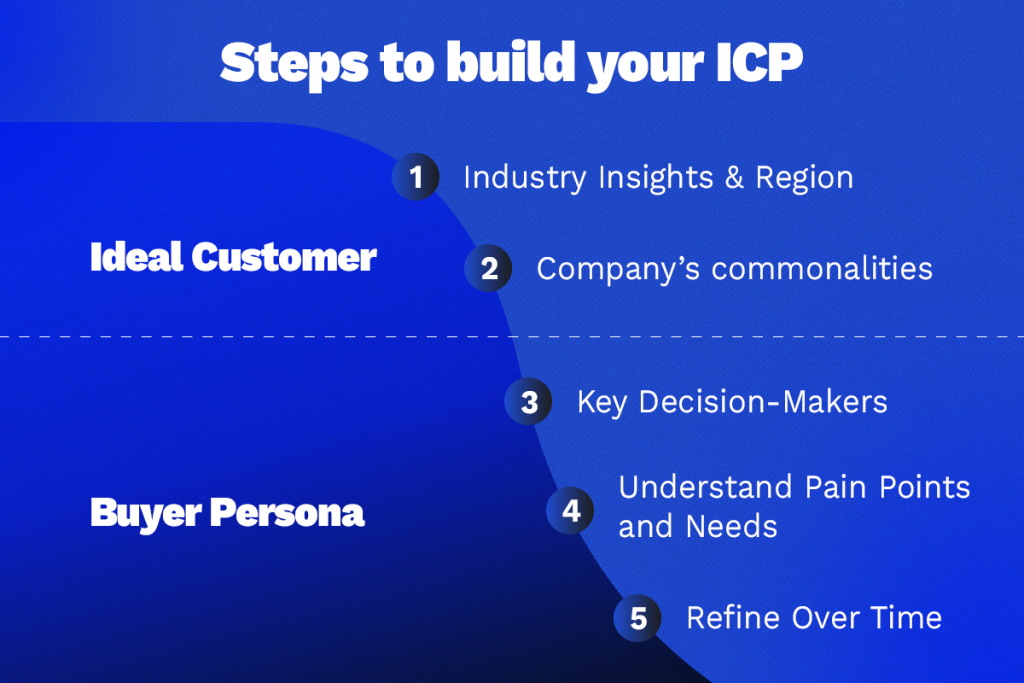Defining your Ideal Customer Profile & Buyer Persona Step-by-Step
When starting any B2B marketing campaign, having a clear Ideal Customer Profile (aka ICP) in mind is crucial. We are talking about those accounts you want to reach, the ones most likely to be interested in your product or service. It’s important to note that an ICP differs from a buyer persona. The first one mostly refers to companies, while the second is closer to the specific people who will buy from you.
So, call it manifestation or call it strategy, the more precisely you define your ICP, the better your results will be.
To effectively engage with your future buyers, your strategy must focus on enhancing customer experience, you have heard this a million times. But, none of this starts without a deep understanding of your ICP and buyer persona.
At Vrand, we’ve crafted a reliable process that moves seamlessly from identifying the ICP to defining a detailed buyer persona, to ensure effective lead engagement. We like to imagine it as something similar to the following waterfall.

1. Industry Insights & Region
Let’s look at the big picture and start with industries.
At Vrand, we mainly work with tech companies that often serve diverse industries—healthcare, finance, logistics, and more—each with its dynamics. We think it can be key to ask yourself questions such as:
- Which industries do we currently serve?
- In which industries have we achieved the best success stories? (This a key point to remember when crafting messages afterward!)
- Where do we see the market grow in the upcoming years?
You got the idea…
Choosing 3 to 4 key industries to start with is helpful when defining messages and ensuring that your outreach is relevant to your potential leads’ sector-specific needs.
Now, regarding geographical regions, selecting the right one mainly depends on your company’s current markets and the growth plans you have set for the upcoming months.
2. Company’s commonalities
Now that you know which industries you will focus on, you can start thinking about the points in common between your ideal companies.
By analyzing existing customer data you can more easily identify commonalities among high-value accounts.
These means could mean answering questions like:
- Do I have an ideal company size in mind? Remember that for B2B you will more likely be moving between 200 and 1K employees (but there are exceptions, of course!)
- Do we know of any specific technologies or tools they use? (for example, AWS, Salesforce, or others.)
- Are there other important activity patterns? (if they are currently hiring, if their IT department has a minimum number of employees, etc.)
While revenue is another piece of data that is usually considered at this point, we have noticed that data sources are usually not updated or not reliable enough to be considered as a main filter when choosing ICPs.
3. Key Decision-Makers
For B2B technology companies, the buying process often involves multiple stakeholders. So we should outline not only the companies to target but also the decision-makers within those companies.
You will want to consider two main points when thinking about these decision-makers.
- Which departments are key? For example, Information technology and Human Resources.
- What’s their job seniority? This last one mainly focuses on C-levels and Directors.
Beware! The bigger the company, the lower the job seniority you can target. For example, the CEO of Bank of America won’t likely reply to your messages, but one of their IT managers could!
This rule also applies in the inverse, meaning in smaller companies or startups, you can target and easily meet CTOs, CFOs, and more. Consider this when working on your buying persona.
At Vrand, we help clients identify the personas involved in the buying cycle and tailor outreach efforts to engage them at the right stage of their decision-making process.
4. Understand Pain Points and Needs
Let’s go one step further into our ICP & buyer persona key points. In our process, we need to focus on understanding what drives our customers’ challenges—whether it’s operational inefficiency, scalability issues, or digital transformation hurdles.
By aligning these pain points with your offering, we can ensure the leads we generate resonate with the problems your product or service tackles.
5. Refine Over Time (or analyze and repeat)
We know that people are not static, things change, the market evolves, and so should your ICP.
Once you start using your ICP in marketing campaigns, you will need to review performance data to refine your ICP and buyer persona as required.
This approach ensures that you are consistently targeting the right leads, increasing the chances of setting meetings with prospects that align with your business goals.
In sum, a well-defined Ideal Customer Profile (ICP) and buyer persona are the cornerstones of any successful B2B marketing campaign.
While not exhaustive, these steps are a good starting point to understand your target industries, identify commonalities among companies, recognize key decision-makers, and address their pain points, setting the foundation for more effective lead generation.
At Vrand, we take a strategic approach to ICP and buyer persona development, ensuring that campaigns remain relevant as market conditions evolve.
Would you like some help defining your company’s Ideal Customer Profile? Learn more about it in a quick call with our team. Contact us today at info@vrand.biz


